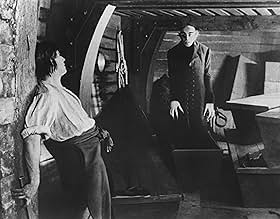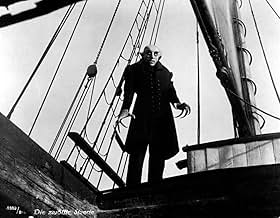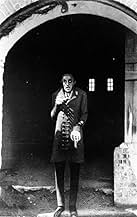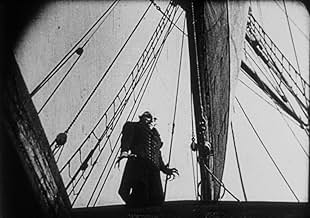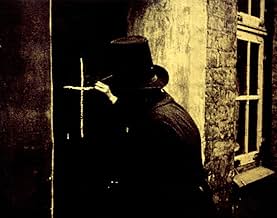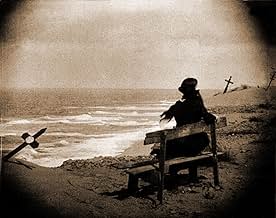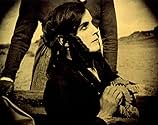El vampiro conde Orlok manifiesta su interés por una nueva residencia y por la esposa del agente inmobiliario Hutter.El vampiro conde Orlok manifiesta su interés por una nueva residencia y por la esposa del agente inmobiliario Hutter.El vampiro conde Orlok manifiesta su interés por una nueva residencia y por la esposa del agente inmobiliario Hutter.
- Dirección
- Guión
- Reparto principal
- Premios
- 3 premios y 2 nominaciones en total
Gustav von Wangenheim
- Hutter
- (as Gustav v. Wangenheim)
Greta Schröder
- Ellen - seine Frau
- (as Greta Schroeder)
Georg H. Schnell
- Harding - ein Reeder
- (as G.H. Schnell)
Karl Etlinger
- Kontrolleur am Kai
- (sin acreditar)
Hans Lanser-Ludolff
- A magistrate
- (sin acreditar)
Loni Nest
- Child at Window
- (sin acreditar)
Fritz Rasp
- Knocks Mitarbeiter
- (sin acreditar)
Josef Sareny
- Head Coachman
- (sin acreditar)
Fanny Schreck
- Krankenschwester im Hospital
- (sin acreditar)
Eric van Viele
- Matrose 2
- (sin acreditar)
Reseñas destacadas
F.W. Murnau set the bar high for vampire movies, very high. Can not help but start praising the job Max Schreck and Murnau did to bring Count Orlok character to life on the screen. Orlok's face, hands and slender build along with his sly shuffling movements with the right camera angles and props brought a hell of a lot of general creepiness. The viewers in the twenties must have been shell shocked because they didn't tame it down which they most often did in this time period. For a full length silent feature film I found the time going fairly fast with a view dragged out scenes, that can be expected. The big bugaboo I have with Nosferatu though is the questionable ending being terribly anticlimactic. Regardless of the disappointing ending, Nosferatu is a killer film that is a must watch for horror or classic movie fans.
I watched the Kartes Video Communications 1984 video cassette version on a 15 inch screen. Titles were in English. Film quality was good. Sound was matched to action. Cropping appeared good, and titles were completely visible. This should give an idea of the technical quality of the release I watched.
Nosferatu is one of the few silent movies with a significant following today. It deserves a following. The film is a suspense piece. Still it is paced nicely so that it feels tense in the right places but never goes long enough without something happening so as to be boring.
Visually Nosferatu forms the precedent for the vampire in movies. The main difference is that Count Nosferatu has more affinity with rat than bat. Aside from this the main stream image of the vampire is based heavily on Nosferatu. This film has been as influential on modern vampire mythology as the novel Dracula. It is based on the novel Dracula. Especially disturbing to me personally are NosferatuÕs twisted hands.
In terms of the filmÕs being silent, this should not put anyone off. The suspense/ horror genre fits well into this medium. I was lucky enough to see a version with music matched to the scenes, but if the copy you are watching has a bad sound track just play some music you like.
I recommend this film to anyone interested in the horror or suspense films. It is a bit of a cult film, but this does not keep it from being actually good.
Nosferatu is one of the few silent movies with a significant following today. It deserves a following. The film is a suspense piece. Still it is paced nicely so that it feels tense in the right places but never goes long enough without something happening so as to be boring.
Visually Nosferatu forms the precedent for the vampire in movies. The main difference is that Count Nosferatu has more affinity with rat than bat. Aside from this the main stream image of the vampire is based heavily on Nosferatu. This film has been as influential on modern vampire mythology as the novel Dracula. It is based on the novel Dracula. Especially disturbing to me personally are NosferatuÕs twisted hands.
In terms of the filmÕs being silent, this should not put anyone off. The suspense/ horror genre fits well into this medium. I was lucky enough to see a version with music matched to the scenes, but if the copy you are watching has a bad sound track just play some music you like.
I recommend this film to anyone interested in the horror or suspense films. It is a bit of a cult film, but this does not keep it from being actually good.
Nosferatu is a great horror movie (possibly the first ever according to some accounts), and one of the pinnacles of the German silent era of film-making. Made in the silent age by the German expressionist/auteur FW Murnau, the film has the genuine power to act creepy, odd, alluring, mythic, and beautiful by way of images and music that don't leave your mind once the film is over. It's like someone collected a stash of nightmares and pulled them together with the original Bram Stoker story of Dracula. Max Shreck, in his most notorious role (and apparently the only one really anyone's bothered to see) plays the monstrous Count Orlock, a vampire who comes out at night to tempt the living and, of course, to suck blood. Though this story of Dracula has been numerously repeated (even by the Hollywood version in the early 30s), this film is one of the prime examples of how horror SHOULD be done- dispense with cheap thrills or overloading with exposition.
A director like Murnau here, who had total artistic control (abeit the film not in circulation for many years), could transform Orlock's world into one of acute, deliberate angles, long deep shadows, and painting with light like some mad artist from the dark ages. One could almost claim that this, alongside Night of the Living Dead, changed the way audiences looked at horror films, that a style and presence could be wrung from characters that bring out the worst fears and dread in common people. Years from now, long into the digital age, there may still be room for of all things a silent, non-talking effort like Nosferatu, where the terror can still be felt through the black and white (sometimes tinted) photography and stark physical performances by Schrek and the others. In short, a film like this is one of the reasons I love to watch horror movies.
A director like Murnau here, who had total artistic control (abeit the film not in circulation for many years), could transform Orlock's world into one of acute, deliberate angles, long deep shadows, and painting with light like some mad artist from the dark ages. One could almost claim that this, alongside Night of the Living Dead, changed the way audiences looked at horror films, that a style and presence could be wrung from characters that bring out the worst fears and dread in common people. Years from now, long into the digital age, there may still be room for of all things a silent, non-talking effort like Nosferatu, where the terror can still be felt through the black and white (sometimes tinted) photography and stark physical performances by Schrek and the others. In short, a film like this is one of the reasons I love to watch horror movies.
F.W. Murnau's version of the 'Dracula' legend still remains as distinctive and memorable as ever. The enjoyable Bela Lugosi version is perhaps easier to watch, and strictly as light entertainment it might work better, and many later versions brought their own interpretations - but nothing matches "Nosferatu" for its engrossingly morbid atmosphere and its unusual interpretation of the main character.
Max Schreck and Murnau were able to create an image of the vampire that remains in your mind long after seeing it. Regardless of whether it or some other conception is closest to the 'true' Dracula (if such a thing even exists), it is quite effective, and it was particularly well-conceived for a silent screen version that cannot rely on dialogue to define a character. The settings and the story perfectly complement Schreck's weird character, creating an atmosphere full of constant strangeness, uncertainty, and foreboding.
It's unnecessary (and probably impossible) to make detailed comparisons among all the film versions of the Dracula character and legend. "Nosferatu" stands perfectly well on its own, as a unique and skillfully done adaptation of the story, and as one of the memorable classics of the silent era.
Max Schreck and Murnau were able to create an image of the vampire that remains in your mind long after seeing it. Regardless of whether it or some other conception is closest to the 'true' Dracula (if such a thing even exists), it is quite effective, and it was particularly well-conceived for a silent screen version that cannot rely on dialogue to define a character. The settings and the story perfectly complement Schreck's weird character, creating an atmosphere full of constant strangeness, uncertainty, and foreboding.
It's unnecessary (and probably impossible) to make detailed comparisons among all the film versions of the Dracula character and legend. "Nosferatu" stands perfectly well on its own, as a unique and skillfully done adaptation of the story, and as one of the memorable classics of the silent era.
I despise most vampire stories. Not even Florence Stoker's dear departed husband could keep me occupied after the first act in Transylvania in "Dracula". The vampire has been so romanticized as an archetype (particularly during the '90s) that I can't but feel that most horror fans have forgotten exactly what made us afraid of these guys to begin with. Murnau's "Nosferatu" is just such a reminder and, because of that, is the only screen version of "Dracula" that I have ever loved.
Though Murnau, in the hopes of dodging the copyright bullet, took many liberties with the novel, he actually shot a great part of the film on location (an unusual practice for the time) in the historical Dracula's old stomping grounds: the Carpathian Mountains in Romania. The town, landscapes, and castles were all for real, not just some fancy studio backdrop. To me, it helps convey the tone of authenticity, as you can believe this story being told. As for Max Schreck, no charming, suave seducer is he. With his bald head, bushy eyebrows, rat-like teeth, pointed ears, nails as long as the fingers they are attached to, emaciated build, and stare that seems to come from the bottom of Hell itself, he is the primal, archetypal image of the vampire of legend.
While some could interpret this tale as a subtext to Nazism or anti-Semetism, at it's core, it's simply the tale of a monster, who brings ruin and death in his wake. That such a tale has managed to survive it's era, considering the obstacles that could have totally removed it from view, is the gain of all who have seen. Eat your heart out, Bela Lugosi.
Though Murnau, in the hopes of dodging the copyright bullet, took many liberties with the novel, he actually shot a great part of the film on location (an unusual practice for the time) in the historical Dracula's old stomping grounds: the Carpathian Mountains in Romania. The town, landscapes, and castles were all for real, not just some fancy studio backdrop. To me, it helps convey the tone of authenticity, as you can believe this story being told. As for Max Schreck, no charming, suave seducer is he. With his bald head, bushy eyebrows, rat-like teeth, pointed ears, nails as long as the fingers they are attached to, emaciated build, and stare that seems to come from the bottom of Hell itself, he is the primal, archetypal image of the vampire of legend.
While some could interpret this tale as a subtext to Nazism or anti-Semetism, at it's core, it's simply the tale of a monster, who brings ruin and death in his wake. That such a tale has managed to survive it's era, considering the obstacles that could have totally removed it from view, is the gain of all who have seen. Eat your heart out, Bela Lugosi.
¿Sabías que...?
- CuriosidadesThe movie was banned in Sweden due to excessive horror. The ban was finally lifted in 1972.
- Pifias(at around 30 mins) When Hutter is writing his letter to Ellen in Count Orlok's castle, the paper that he is meant to be writing on is clearly blank throughout the scene.
- Citas
Graf Orlok: Your wife has such a beautiful neck...
- Versiones alternativasThere are a confusing number of different surviving prints, restorations and alternate versions of Nosferatu. In the main, there are three 'complete' restorations and two incomplete, partially-restored versions. All five are available on DVD, while the latest two restorations, from 1995 and 2006, are also on Blu-ray. In addition there are countless low-quality public domain DVDs with different lengths, running speeds and soundtracks. All are derived from a single print held by the Museum of Modern Art (MoMA). They usually have replacement American intertitles and are always in black and white; the film was originally color tinted throughout and only meant to be seen that way. This comprehensive article explains all of them simply and clearly: Nosferatu: The Ultimate Blu-ray and DVD Guide.
- ConexionesEdited into Boo (1932)
- Banda sonoraJeux d'enfants - Galop
Written by Jack Norworth
[Plays during the croquet scene in the 2006 restoration]
Selecciones populares
Inicia sesión para calificar y añadir a tu lista para recibir recomendaciones personalizadas
- How long is Nosferatu: A Symphony of Horror?Con tecnología de Alexa
- How many different versions exist of 'Nosferatu'?
Detalles
- Fecha de lanzamiento
- País de origen
- Sitio oficial
- Idiomas
- Títulos en diferentes países
- Nosferatu, una simfonia del terror
- Localizaciones del rodaje
- Starhrad Castle, Nezbudská Lúcka, Slovakia(castle in ruins)
- Empresas productoras
- Ver más compañías en los créditos en IMDbPro
Taquilla
- Recaudación en todo el mundo
- 48.892 US$
- Duración1 hora 34 minutos
- Mezcla de sonido
- Relación de aspecto
- 1.33 : 1
Contribuir a esta página
Sugerir un cambio o añadir el contenido que falta



